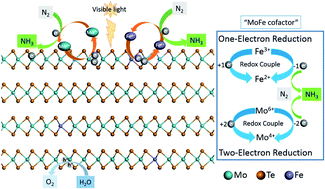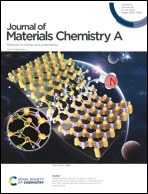The in-built bionic “MoFe cofactor” in Fe-doped two-dimensional MoTe2 nanosheets for boosting the photocatalytic nitrogen reduction performance†
Abstract
In biological nitrogen fixation systems, the MoFe cofactor of nitrogenase plays a crucial role in enhancing the activation of dinitrogen to drive the nitrogen reduction reaction. However, the development of effective bionic inorganic photocatalysts still remains a great challenge and the photocatalytic system of both Mo- and Fe-based semiconductors for nitrogen reduction is rarely studied. In this work, a novel photocatalytic nitrogen reduction bionic system based on Fe-doped two-dimensional MoTe2 nanosheets has been proposed. The bionic “MoFe cofactor” formed by introducing iron into MoTe2 can effectively facilitate the transport and separation of photo-generated charge carriers by one-electron and two-electron redox reactions and 15 times longer photocarrier lifetime. As a result, the photocatalytic nitrogen reduction activity of Fe-doped MoTe2 is obviously boosted, which is about 11-fold higher in comparison to that of pure MoTe2. The presented work provides an effective route to design novel bionic Mo–Fe inorganic two-dimensional semiconductor photocatalysts for nitrogen reduction.

- This article is part of the themed collection: Journal of Materials Chemistry A HOT Papers


 Please wait while we load your content...
Please wait while we load your content...